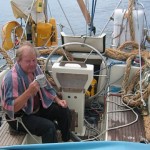Another tale of a tangle!
Reading Peter Wright’s article about Dream Machine’s net-fouling problem in Flushing revived recent memories of a problem we encountered in Kjempekjekk during a S Brittany cruise last summer.
We were originally headed for Corunna from Fowey but for a couple of very good reasons had modified our plan en route and turned left toward La Rochelle. Which is why we came to be 25 miles west of Raz de Sein on a calm afternoon, donking along gently to clear the southern end of the Ushant TSS.
Suddenly there was a loud bang and the engine and KJ quickly stopped. Looking aft we saw two long ends of thick multi-plait rope streaming astern!!
We quickly gathered up the free ends and hauled them inboard. No amount of pulling or pushing seemed to work; the engine gear lever wouldn’t move so the only thing for it was to go overboard and look. Luckily we had snorkel and flippers aboard and the weather was fair although KJ was rolling quite heavily at times.
On the first dive I was able to get a good purchase on the prop and managed to take the pressure off the gearbox so that the gear lever would function normally and we could then get it into neutral and unwind most of the rope. We have a rope cutter fitted to KJ’s saildrive folding propellor – one of those vicious fir-tree profile things – and the multiplait had become firmly engaged in the cutting teeth as well as the teeth of the propeller blade rack. So we started cutting and over the next two hours wrecked every sharp knife we had, including a Stanley knife and two razor-sharp fish filleters.
We still hadn’t made any significant progress when I remembered the hacksaw. From then on it was relatively easy and it’s amazing how it renewed our determination and this probably generated adrenalin which in turn seemed to let me stay under for longer. Anyway, after nearly two and a half hours of diving, cutting and gasping we were free.

So what did we learn?
-
First and most obvious is that rope cutters have their limits. I know for a fact that ours has prevented fouling on two occasions – once SE of Cape St Vincent, and again near the Azores, so perhaps I’d become a little complacent. Then there is the value of a good boarding ladder – luckily we had one. The star of the whole event was the hack-saw and although ours is now a bit rusty I’ll never throw it away – in fact we have a new one with plenty of spare blades.
-
On the first few dives I wore a line round my waist, secured to the boat. Then I noticed it drifting towards the rope cutter but managed to pull it clear just before it snagged. From then on it was discarded and I felt much happier.
-
We didn’t see the rope until it was far too late! The marine life in the strands indicated that it must have been afloat for some time and it is reasonable to suppose that it was barely afloat, however, perhaps a more thorough lookout ahead with binoculars might have enabled us to avoid it.
-
When funds and circumstances allow, at least one of us should learn to dive and we’ll invest in a basic diving set. And finally of course, it’s only proper to take one’s rubbish home; so in the coming spring we’ll make some sort of garden feature out of 100ft of towing hawser!
David & Liz Jolliff Jan 2006
